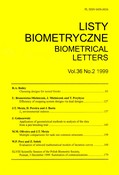
Listy Biometryczne-Biometrical Letters Vol.36(2), 1999, pp.145-157


In the field experiments the effects of spatial variability inflate the estimate of experimental error. As a result these effects can mask real treatment effects. The main problem considered in the paper is an improvement of the statistical analysis by using additional information about soil fertility trends and possible competitive interference between neighbouring plots. The basis of the consideration were the data from the field experiment with pea arranged as the balanced lattice design with 25 treatments. Among the statistical methods used were: ANOYA for completely randomized design, randomized block design and balanced incomplete bock design and ANCOYA. Kriging and Papadakis’ nearest neighbour analysis were used to calculate the concomitant variables connected with the soil characteristics (pH and P, K, Mg) and interplot competition. To compare different statistical methods the relative efficiency was established. Kriging applied for yield analysis and nearest neighbour analysis applied for plant height analysis significantly reduced the experimental error. It was stated that the methods can be good supplemental tools in improving the evaluation of treatments in breeding trials with pea.

Pea, block design, incomplete block design, ANOYA, ANCOYA, nearest neighbour analysis, geostatistics, kriging

